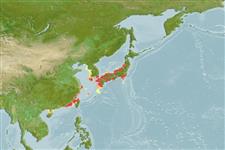>
Gobiiformes (Gobies) >
Gobiidae (Gobies) > Gobiinae
Etymology: Istigobius: Greek, istios = sail + Latin, gobius = gudgeon (Ref. 45335).
More on author: Tanaka.
Environment: milieu / climate zone / depth range / distribution range
Ecología
marino demersal; rango de profundidad 3 - 14 m. Tropical; 40°N - 20°N
Distribución
Países | Áreas FAO | Ecosistemas | Ocurrencias, apariciones | Point map | Introducciones | Faunafri
Northwest Pacific: southern Japan, southern Korea, and Hong Kong. Reported from the Penghu Islands (Ref. 55073).
Tamaño / Peso / Age
Maturity: Lm ? range ? - ? cm
Max length : 8.9 cm TL macho / no sexado; (Ref. 420); 7.7 cm TL (female)
Espinas dorsales (total): 7; Radios blandos dorsales (total): 11; Espinas anales 1; Radios blandos anales: 10; Vértebra: 26. Upper pectoral fin rays entire. Cycloid predorsal scales 13-17, ctenoid on trunk. No scales on antero-dorsal part of operculum. A large diagonal blue stripe beneath the eye from corner of mouth to dorsal most part of preoperculum. Only males with a black spot distally on membranes between IV and VI spines of 1st dorsal fin.
Common on sand or mud bottoms in shallow water. May be solitary or in small schools near crevices or under stones. Lays its eggs under shells where males care for the young; spawning took place from May to July.
Life cycle and mating behavior
Madurez | Reproducción | Puesta | Huevos | Fecundidad | Larva
Genital papilla of male heavily pigmented near the base; ending at the anal fin origin. Female genital papilla truncate & ending well before anal spine. Eggs laid under shells or rock surfaces.
Murdy, E.O. and D.F. Hoese, 1985. Revision of the gobiid fish genus Istigobius. Indo-Pac. Fish. (4):41 p. (Ref. 420)
IUCN Red List Status (Ref. 130435)
Threat to humans
Harmless
Human uses
Más información
PaísesÁreas FAOEcosistemasOcurrencias, aparicionesIntroduccionesStocksEcologíaDietacomponentes alimenticiosconsumo de alimentoRación
ReferenciasAcuiculturaPerfil de acuiculturaRazasGenéticaElectrophoresesheritabilidadEnfermedadesProcesamientoNutrientsMass conversion
Herramientas
Special reports
Download XML
Fuentes de Internet
Estimates based on models
Preferred temperature (Ref.
123201): 16.1 - 24.1, mean 20.3 °C (based on 157 cells).
Phylogenetic diversity index (Ref.
82804): PD
50 = 0.5010 [Uniqueness, from 0.5 = low to 2.0 = high].
Bayesian length-weight: a=0.01023 (0.00477 - 0.02194), b=3.02 (2.84 - 3.20), in cm total length, based on LWR estimates for this (Sub)family-body shape (Ref.
93245).
Nivel trófico (Ref.
69278): 3.3 ±0.4 se; based on size and trophs of closest relatives
Resiliencia (Ref.
120179): Alto, población duplicada en un tiempo mínimo inferior a 15 meses (Preliminary K or Fecundity.).
Fishing Vulnerability (Ref.
59153): Low vulnerability (10 of 100).
